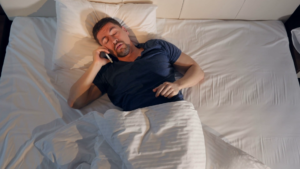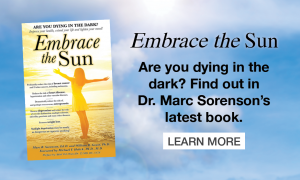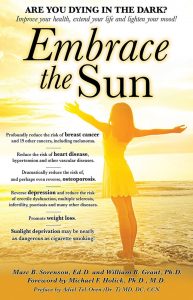The phone, sunlight and sound sleep. By Marc Sorenson, EdD. 
The phone is ubiquitous, and it may be taking away a basic human need: sound and restful sleep.
How should the sleep/wake cycle work?
First of all, we awake to bright sunshine. Light enters the eye and stimulates serotonin production. Serotonin is a natural “upper” and mood elevator. Thus, we quickly become awake and invigorated. The bright sunshine also suppresses melatonin, the sleep inducer. Yet at evening light disappears (at least that is how nature intended it), melatonin levels rise, and serotonin levels diminish. We begin to feel sleepy and ideally retire for a good night’s rest. It is a perfect system for our needs—unless we stay up beyond biologically natural hours by using artificial lighting.
Then, the phone throws a wrench into the works!
Particularly, a phone, tablet, computer monitor and other electronic device that emits blue light can interfere with sleep cycles. This may leave you wide-awake and staring at the ceiling when you should be sleeping peacefully. Furthermore, you may feel “out of sync” the next day due to lack of rest. We hear a plethora of advice about using blue-blocker screens, and heaven forbid, giving up the devices at night! Regrettably, however, some humans would rather die than not check their devices just before, and many times during, bedtime. Perhaps they are incorrigibly addicted to the phone, tablet, etc. In addition, such activities inhibit melatonin secretion. Best to eschew the phone by night and embrace the sun by day!
So, is there any way to cater to our phone addictions and still get some shut-eye?
An interesting study showed that exposure to constant bright light, for several hours daily, stopped sleeplessness and let melatonin dominate at night. The researchers compared subjects reading a book (no blue light) and a tablet (lots of blue light). They also assessed sleep patterns and melatonin concentrations. Both groups had identical results for melatonin and sleep patterns. From this research, it appears that we can have our cake and eat it too, provided we receive plenty of sunlight. Most noteworthy was that it was not lack of blue light (when the devices were removed) that enhanced sleep. Rather, it was the bright light exposure in the day. Hence, we can evade sleep-deprivation punishment for  excessive device use if we take our time in the sunlight!
excessive device use if we take our time in the sunlight!
So is there other research indicative of the night-time-sleep-inducing effects of daytime sun exposure?
There are several. For a full discussion, I suggest you read my book, Embrace the Sun, co-authored by Dr. William Grant.
Another investigation established that people whose workplaces have windows are able to sleep about 46 minutes per night longer on average, than those who have no natural light access. Those with windows also are generally happier, have fewer ailments, and experience better vitality than their window-less counterparts.
Why is sleep so important to health, regardless of cell phone, sunlight, etc.?
Another article shows that too little sleep can be deadly. Forbes Magazine online printed an excellent article on sunlight and sleep, which listed the following horrendous statistics: “In 2012, 60 million Americans filled prescriptions for sleeping pills, up from 46 million in 2006.” The article discusses the potential dangers of sleep medications, showing that those who take 18 sleeping pills per year have a tripling of the risk of death compared to those who take fewer than 18.
Do not expect the drug companies to be touting these stats. Take matters in your own hands and get some daily, non-burning sun exposure. In addition, read Embrace the Sun,
Obesity in children: Caused by pregnant mom’s sun deprivation? By Marc Sorenson, EdD. 
Obesity in children is linked closely to maternal vitamin D status in pregnancy.[1] And is anyone surprised about this? First of all, everyone should know that vitamin D deficiency is caused by inadequate sun exposure. So, if high vitamin D is associated with less weight, it is because of high sun exposure. That is of course, unless the research involves vitamin D supplementation. Because sunlight produces nitric oxide, endorphin, serotonin, dopamine and other chemicals, only research can determine if vitamin D is protective. Therefore, a supplementation study would be required.
What did the research show regarding obesity?
It seems like sun exposure, which produces all of the photoproducts, would always be the best way to prevent weight gain. Most noteworthy, however, is that we are discussing only the sun deprivation aspects of obesity. That is because being overweight is primarily due to 1. eating junk food and 2. not staying active. This blog, however, deals only with extra weight due to sun deprivation.
So what did this obesity study show? To perform the research, pregnant women were first of all measured for vitamin D levels before birth. In addition, their newborns were followed for 4-6 years and then compared for obesity levels. In conclusion, those whose mothers had the lowest vitamin D levels had children with the greatest obesity problems.
So, we still don’t know if vitamin D was the protective photoproduct against obesity in children. Because of that lack of surety, let’s visit some research on sunlight and obesity.
In addition to the aforementioned research, another scientific paper “sheds more light” on the subject of obesity.[2]
This research was conducted on mice with shaved backs, because the applied light needed to be unimpeded by hair. Also, a second part of the experiment was to put them on a high-fat diet. Finally, they were exposed to non-burning ultraviolet radiation (UVR) during a three-month period. (UVR is the same light they would receive from sunlight). The mice, because of the high-fat diet, would have been expected to gain weight rapidly. But with UVR, the weight gain was consequently (and impressively) reduced. As a result of the treatment the mice achieved 30-40% less weight gain. That is, compared to the expected weight gain.
Blue light for reduced obesity?
Furthermore, a study published in 2017 showed that the blue-light spectrum of sunlight can cause subcutaneous fat to decrease.[3] In other words, it can cause obesity to diminish, much as good nutrition would also cause it to decrease. Thus, the action of sunlight may help one to prevent obesity or even to create slimness. Consequently, blue light from the sun may be a preventer of obesity, and an adjunct to good nutrition and exercise.
Is obesity reduced by morning light?
So—here we have another benefit of sun exposure—morning sun specifically! A recent study from Northwestern Medicine demonstrates that timing and intensity of light correlate with body mass index (BMI).[4] So to understand the research we need to understand BMI. BMI is a numerical computation comparing height and weight. And it is a commonly used method to assess obesity or the lack thereof. So a high BMI usually means a person is obese or at least approaching obesity. Optimal BMI is 18-25. Below 18 is considered underweight, above 25 is overweight, 30 is obese and 40 and above is morbidly obese.
So does sun exposure influence BMI? Is obesity reduced?
This study showed, first of all, that exposure to bright morning light was directly related to BMI. After adjusting for confounders, it was determined that very early exposure to morning light correlated remarkably to lower BMI. Opposite to what one might expect, when light intensity was equal at different times of the day, results were identical. Consequently, those who received the earliest bright light had lower BMI. Furthermore, for each hour later in the day when light exposure occurred, BMI increased by 1.3 units. This fact is exceptionally important, since a person who has a BMI of 25 (upper ideal range) could approach 30 (obesity). And that would be due to the habit of later sun exposure (10:00 AM rather than 6:00 AM).
Does vitamin D supplementation help prevent obesity?
Another scientific paper “sheds more light” on the subject of obesity.[5] This research was conducted on mice with shaved backs that were placed on a high-fat diet and then exposed to non-burning ultraviolet radiation (UVR) during a three-month experiment. The mice, without the benefit of UVR, would have been expected to gain weight rapidly on that diet, but when they were exposed to UVR, the weight gain was impressively reduced. The UVR treatment achieved a 30-40% reduction in weight gain, compared to the expected weight gain with the high-fat diet.
Interestingly, when vitamin D supplementation was used, it did not help, and actually stopped the positive effects of UVR treatment.
In conclusion, the pandemic of obesity may be exacerbated by sun deprivation. And, it may be due to something other than low vitamin D. Expectant mothers and their children should always obtain plenty of non-burning sun exposure. So should most other members of the human race. Happy sunning! 
Also see: http://sunlightinstitute.org/sun-exposure-reduces-obesity-vitamin-d-not
Read My book, Embrace the Sun, available at
Time limit is exhausted. Please reload CAPTCHA.
[1] V. Daraki T. Roumeliotaki G. Chalkiadaki M. Katrinaki M. Karachaliou V. Leventakou M. Vafeiadi K. Sarri M. Vassilaki S. Papavasiliou M. Kogevinas L. Chatzi. Low maternal vitamin D status in pregnancy increases the risk of childhood obesity
[2] Geldenhuys S, Hart PH, Endersby R, Jacoby P, Feelisch M, Weller RB, Matthews V, Gorman S. Ultraviolet radiation suppresses obesity and symptoms of metabolic syndrome independently of vitamin D in mice fed a high-fat diet. Diabetes. 2014 Nov;63(11):3759-69
[3] Ondrusova K, Fatehi M, Barr A, Czarnecka Z, Long W, K Suzuki K, Campbell S, Philippaert K, Hubert M, Tredget E, Kwan P, Touret N, M Wabitsch M, Lee K, Peter E. Light P. Subcutaneous white adipocytes express a light sensitive signaling pathway mediated via a melanopsin/TRPC channel axis. Scientific Reports 2017 November 27;7:16332
[4] Reid KJ, Santostasi G, Baron KG, Wilson J, Kang J, Zee PC. Timing and intensity of light correlate with body weight in adults. PLoS One 2014;2;9(4)
[5] Geldenhuys S, Hart PH, Endersby R, Jacoby P, Feelisch M, Weller RB, Matthews V, Gorman S. Ultraviolet radiation suppresses obesity and symptoms of metabolic syndrome independently of vitamin D in mice fed a high-fat diet. Diabetes. 2014 Nov;63(11):3759-69
 What is blue light?
What is blue light?
Blue light is a light spectrum, emitted by the sun. It also emitted by technology devices and therefore has fallen into disrepute. First of all, blue light in the evening (typical with TV/Computer/Cellular phones) is not healthful. It is especially relevant that it inhibits melatonin, which is needed for sound sleep.[1] [2] Hence, we are warned about the deleterious effects of using our phone, tablets, TVs and computer late at night.
Is blue light both good and bad?
In addition, melatonin has anti-cancer properties.[3] However, while blue light exposure reduces evening melatonin (bad), it also inhibits melatonin production during the day (good). Why? Because melatonin lets the body relax and sleep. That is the last thing we want by day, because we should be alert and working. Blue light, while reducing melatonin at night, is wonderful by day. Another positive effect is its ability to call T-cells (important immune-system cells) into play.[4] And of course, T-cells are soldiers that can destroy noxious, invading microorganisms.
What more can blue light do?
In addition, full–body exposure to blue light decreases blood pressure, lessens arterial stiffness, and improves endothelial function.[5]
Another attribute is its ability to cause subdermal fat tissue to decrease in size.[6] In other words, it can cause fat loss. Thus, the action of sunlight may help one to stay slim or become slim. The researchers showed that daily exposure of fat cells to blue light resulted in decreased lipid droplet size and increased fat breakdown rate. The researchers had been doing research on light and diabetes, and they serendipitously found that the light could be an asset in maintaining (or producing) a slim body.
Set your circadian rhythm.
Blue light also helps to reset the circadian rhythm of the body.[7] In conclusion, remember that blue light, which is particularly beneficial during the daytime, is disruptive at night and inhibits melatonin, needed for sleep. Therefore, get out in the early morning and get your share of blue light throughout the day. And when it becomes dark, go to bed early and avoid blue light. Avoid sunburn when you are soaking up the sun. Simply cover up when you have had enough, and avoid sunscreens, which have been shown to actually increase sunburning.
Learn more!
To learn all the facts about the healthful effects of sunlight, read my book, Embrace the Sun, available at Amazon. https://www.amazon.com/Embrace-Sun-Marc-B-Sorenson/dp/069207600X 
[1] Vandewalle G, Collignon O, Hull J.T, Daneault V, Albouy G, Lepore F, et al. Blue light stimulates cognitive brain activity in visually blind individuals. J Cogn Neurosci. 2013 Dec;25(12):2072.
[2] Knufinke M, Fittkau-Koch L, Møst EIS, Kompier MAJ, Nieuwenhuys A. Restricting short-wavelength light in the evening to improve sleep in recreational athletes – A pilot study. Eur J Sport Sci. 2018 Nov 14:1-8. [Epub ahead of print].
[3] de Almeida Chuffa LG, Seiva FRF, Cucielo MS, Silveira HS, Reiter RJ, Lupi LA. Mitochondrial functions and melatonin: a tour of the reproductive cancers. Cell Mol Life Sci. 2018 Nov 14 [Epub ahead of print].
[4] Phan TX, Jaruga B, Pingle SC, Bandyopadhyay BC, Ahern GP. Intrinsic Photosensitivity Enhances Motility of T Lymphocytes. Sci Rep. 2016 Dec 20;6:39479.
[5] Stern M, Broja M, Sansone R, Gröne M, Skene SS, Liebmann J. et al.
[6] Ondrusova K, Fatehi M, Barr A, Czarnecka Z, Long W, et al.. Subcutaneous white adipocytes express a light sensitive signaling pathway mediated via a melanopsin/TRPC channel axis. Scientific Reports 2017 November 27;7:16332.
[7] Bonmati-Carrion MA, Arguelles-Prieto R, Martinez-Madrid MJ, Reiter R, Hardeland R, Rol MA, Madrid JA. Protecting the melatonin rhythm through circadian healthy light exposure. Int J Mol Sci. 2014 Dec 17;15(12):23448-500.
Stay slim with sun exposure?  New, never considered research adds a reason to stay active in the sun:[1] The blue-light spectrum of sunlight, a spectrum that can penetrate the skin, can cause subdermal fat tissue to decrease in size. In other words, it can cause fat loss. Thus, the action of sunlight may help one to stay slim or become slim. The researchers showed that daily exposure of differentiated adipocytes [fat cells] to blue light resulted in decreased lipid droplet size and increased basal lipolytic [fat breakdown] rate.
New, never considered research adds a reason to stay active in the sun:[1] The blue-light spectrum of sunlight, a spectrum that can penetrate the skin, can cause subdermal fat tissue to decrease in size. In other words, it can cause fat loss. Thus, the action of sunlight may help one to stay slim or become slim. The researchers showed that daily exposure of differentiated adipocytes [fat cells] to blue light resulted in decreased lipid droplet size and increased basal lipolytic [fat breakdown] rate.
The researchers had been doing research on light and diabetes, and they serendipitously found that the light could be an asset in maintaining (or producing) a slim body. But there are many other studies that show sun exposure is capable of assisting the body in being slim. For example: here is another benefit of sun exposure—morning sun specifically: A recent study from Northwestern Medicine demonstrates that timing and intensity of light correlate with body mass index (BMI).[2] BMI is a numerical computation comparing height and weight, and is a commonly used method to assess obesity or the lack thereof. A high BMI usually means a person is obese or at least approaching obesity, while optimal BMI is 18-25. Below 18 is considered underweight, above 25 is overweight, 30 is obese and 40 and above is morbidly obese. However, BMI does not work for heavily-muscled people, who may have minimal fat, but whose BMI puts them in an obese category—in reality, they are very slim.
This study showed that exposure to bright morning light was directly related to BMI. After adjusting for confounders such as diet, exercise and timing of sleep, it was determined that very early exposure to morning light correlated remarkably to lower BMI—they were slim, or at least slimmer. Even when light intensity was equal at different times of the day, those who received the earliest bright light had lower BMI. Most noteworthy was the fact that for each hour later in the day when light exposure occurred, BMI increased by 1.3 units. This fact is especially relevant, since a person who has a BMI of 25 (upper ideal range) could approach 30 (obesity), over time, due to the habit of receiving sun exposure later in the day, e.g. 10:00 AM rather than 6:00 AM.
The authors suggested that the mechanisms by which early light exposure could influence the “slim” mechanisms, could be the following: (1) resetting the circadian rhythm (internal clock), (2) the greater quantity of blue light in morning sun and (3) effects on melatonin production. Whatever the mechanisms, we now know that early-morning sun is important to being slim. In addition, it may also be important to other health issues. Rather than think of sun exposure as the cure-all for obesity, we must realize that poor nutritional habits and lack of exercise are much more important. Nevertheless, sun exposure can furnish one more arrow in the quiver.
Sun exposure is far superior to vitamin D supplements in preventing weight gain.
Another scientific paper “sheds more light” on the subject of being slim.[3] This research was conducted on mice with shaved backs that were placed on a high-fat diet and then exposed to non-burning ultraviolet radiation (UVR) during a three-month experiment. The mice, without the benefit of UVR, would have been expected to gain weight rapidly, but when they were exposed to UVR, the weight gain was impressively reduced. Furthermore, the UVR treatment achieved 30-40% less weight gain, compared to the expected weight gain with the high-fat diet. So, not only can sun exposure produce slim humans, it can help to produce slim rats.
Other benefits for the rats included: significant reductions in glucose intolerance, insulin resistance and fasting insulin levels (all markers and predictors of diabetes), nonalcoholic fatty liver disease measures and cholesterol. All of these factors, including obesity, are part of a cluster of maladies known as the metabolic syndrome, or MetS, which is indicative of deteriorating health and susceptibility to heart disease and diabetes. Finally, almost all people who have the aforementioned indications of MetS have a large problem maintaining slim bodies. Not a surprise, eh?
Other interesting findings:
Supplementation with vitamin D actually reduced the aforementioned beneficial effects. Dr. Shelley Gorman, one of the authors, made the following three interesting observations:[4]
- “These findings were independent of circulating vitamin D and could not be mimicked by vitamin D supplementation.”
- “It looked like the presence of vitamin D in mice on the high fat diet prevented the [beneficial] effect of UV radiation on weight gain.”
- She also mentioned the mechanism of weight loss may be dependent on nitric oxide (NO), which originates from diet and can be mobilized by UV radiation to become bioactive. This was due to the fact that in another part of the experiment, skin induction of nitric oxide (NO)—also a product of skin exposure to sun—reproduced many of the positive effects of UVR, something vitamin D supplements could not do.
The Authors conclusions:
The authors concluded their research thusly: These studies suggest UVR (sun exposure) may be an effective means of suppressing the development of obesity and MetS, through mechanisms independent of vitamin D but dependent on other UVR-induced mediators such as NO.”
It has been suggested that since low 25(OH)D levels correlate to obesity, those low levels are a possible cause of obesity. However, vitamin D is stored in fat tissue. Therefore, an increase in fat will lower the quantity of 25(OH)D circulating in the blood. Hence, low vitamin D is a consequence of obesity, and not the cause.[5]
Research continues to mount about the positive effects of sun exposure, independent of vitamin D production. This should in no way be construed to diminish the vital importance of vitamin D. Rather, it is to make a point that sun exposure works in many ways, including stimulating the production of vitamin D, NO, serotonin and endorphins. Why should we be satisfied with any one of these marvelous health aids when the sun is available? Because, with sun exposure, we can enjoy the benefits of the entire package.
So, being slim is dependent on a series of choices: avoiding junk food, eating large quantities of vegetables and fruits, taking a daily walk or engaging in other aerobic exercise, weight training and, finally, soaking up some daily, non-burning sunlight.
In conclusion: Stay slim, my friends.
[1] Katarina Ondrusova, Mohammad Fatehi , Amy Barr, Zofa Czarnecka, Wentong Long, Kunimasa Suzuki, Scott Campbell, Koenraad Philippaert, Matthew Hubert, Edward Tredget, Peter Kwan, Nicolas Touret, Martin Wabitsch, Kevin Y. Lee & Peter E. Light. Subcutaneous white adipocytes express a light sensitive signaling pathway mediated via a melanopsin/TRPC channel axis. Scientific Reports November 27;7:16332
[2] Reid KJ, Santostasi G, Baron KG, Wilson J, Kang J, Zee PC. Timing and intensity of light correlate with body weight in adults. PLoS One 2014;2;9(4)
[3] Geldenhuys S, Hart PH, Endersby R, Jacoby P, Feelisch M, Weller RB, Matthews V, Gorman S. Ultraviolet radiation suppresses obesity and symptoms of metabolic syndrome independently of vitamin D in mice fed a high-fat diet. Diabetes. 2014 Nov;63(11):3759-69
[4] Dr. Shelly Gorman, quoted on Science Network Australia article: Sun shines light on obesity challenge. http://www.sciencewa.net.au/topics/health-a-medicine/item/3618-sun-shines-light-on-obesity-challenge (accessed February 4, 2016)
[5] Cândido FG, Bressan J. Vitamin D: link between osteoporosis, obesity, and diabetes? Int J Mol Sci. 2014 Apr 17;15(4):6569-9.
